Five Money Focused Field Trips To Take With Your Kids
August 23rd, 2022 by Team Sammy

We are pleased to welcome Sharita M. Humphrey, CFEI as a Sammy Rabbit Guest Blogger.
It is a delight to have Sharita contribute her thinking on giving kids money focused filed trips to increase their financial education knowledge.
About Sharita
Sharita M. Humphrey is an award-winning finance expert, money mentor and Certified Financial Education Instructor.
Once broke and homeless, Sharita completely transformed her life. She is now a successful entrepreneur and one of the most in-demand money coaches for individuals and business owners of color.
In 2020, Sharita was named the National Financial Educator of the Year.
You can discover more about Sharita and her mission at SharitaMHumphrey.com

Have Fun Teaching Your Kids About Money
Have you ever thought of taking your kids on a money focused field trip?
Many kids remember a field trip far longer than a classroom lecture.
Experiences are one of the most effective and engaging forms of learning. It's true for everyone, kids and adults.
As kids are exposed to new concepts in a fun and engaging way, you’ll see them absorb financial literacy knowledge and skills like sponges. The adventure may even inspire them to want to practice the personal finance habits that lead them to financial freedom as they grow up.
So, when it comes to financial education, I strongly encourage parents and educators to give kids more money focused field trips.
Below, find five (5) fun, low cost easy to execute field trips that will help any parent or educator teach kids about money.

(1) Field Trip to the Bank
Visit your local bank. It is a fun and free way to help children learn about money and more, like math, business and banking.
Start by calling banks in your area. Find out if they are willing to walk your kids or a classroom of students through a day-in-the-life of money, maybe even their own money!
Kids will get to see and experience the bank vault, lots of cash in all denominations; coins wrapped and unwrapped; tellers counting money and handling deposits and withdrawals; managers and loan officers interacting with customers; ATM machines; debit and credit cards; checks, deposit and withdrawal slips; and much more, perhaps even a tutorial from a manger on investing and/or the difference between simple and compound interest.
I love that the experience provides children an opportunity to see how both money and math can be applied to their daily lives. Lots of kids struggle with math. Many don't understand why it is important or how it applies to their lives. This field trip can change that.
If you can’t find a bank in your area that is open to field trips, then take your kids along with you when you go to the bank. It is a great way to pique their interest in money and to help them better understand their own financial responsibilities.

(2) Field Trip to the Supermarket
You probably already take your kids to the supermarket on a regular basis. Why not periodically take advantage of these regular excursions to add to your child's personal finance knowledge?
Supermarkets contain endless opportunities to sharpen kids money skills.
Start by establishing a tradition of making a grocery list at home. Teach them how you list, plan and budget for the items you need and want to purchase.
Then head to the store. As you shop together, talk about how you make money-wise decisions like:
---properly taking advantage of sales and promotions
---the importance of identifying cost per unit and how to calculate the best deals
---situations where you may be able to save money by using coupons, buying store brands versus name brands, etc.
You get the idea. Remind kids that while treating yourself once in a while is fine, it’s important to stick to your budget and consistently make wise spending choices.
Consistency provides predictable outcomes. Practice what you preach - as much as you are able to. Lead by example and you predict great money sense will become second nature to your kids as they watch and learn from mom and dad.
Enjoy the experience. Be sure your kids do the same. Be creative. There are an infinite number of ways to build on the supermarket learning experience. SEND us some of your favorite suggestions. We will post them as an addendum to this article and/or in social media. Let's all grow our knowledge and kids together!!!

(3) Field Trip to the Mall
While outings to the supermarket largely pertain to food and health, a field trip to the mall expands one's personal finance learning possibilities.
At the mall you and kids can shop for clothes, household goods, technology and just about everything under the sun. With stores selling nearly everything one may need or want, plus providing access to tempting treats around every corner, a field trip to the mall is one of the best places to teach kids about money. It is a sensational place to learn the essentials of money management. Kids are sure to have a blast!
Use the same set up and pre-shopping routine established for going to the supermarket. Work with your kids to create a budget and a shopping plan. This is a proven strategy to set them up for success. Talk and walk them through some of your core values and money management strategies, such as:
---How to stick to a budget
---How to ask the right questions to get the best deals
---Simple ways to calculate sales, tax, and discounts.
---How to save up for certain items they want, rather than spending their whole budget right away.
(4) Field Trip to a Library or Museum
Here is a secret more people should be aware of - libraries and many museums, including mobile museums, are wonderful places to teach your kids about money. And many of them are now making efforts to incorporate financial literacy education into their offerings.
If you think this approach will resonate with your kids, do an online search and see what a local library or museum offers or might considering in the way of youth financial education. Maybe they have existing programs and resources.
Here is a partial list of what I have uncovered. Some true treasures!
---The American Numismatic Association Money Museum
---The Los Angeles’ Connecting Cultures Mobile Museum. This museum is now 20 years old. Thousands of campuses have already experienced their service without leaving their premises. They have a commercial collection that focuses on resources, different kinds of trade, and the history of colonization. Learning about culture and history helps kids understand the importance of money, how it evolved into what it is today, and it’s role in shaping the world we live in. There are artifacts that are free to touch so kids can get hands-on with a 3-dimensional learning experience.
---The Higgins Museum of National Bank Notes
---Museum of American Finance
---The Federal Reserve "Money Museum"
---A good way to discover more about library offerings is by doing the following search: Public Library Association Financial Literacy.

(5) Education Experience at a Money Camp
There are music camps, wilderness camps, and science camps. And yes, there are also money camps.
These camps teach basic financial skills and many related core values. Your kids will learn things like the benefits of saving, budgeting, investing, insurance, compound interest, entrepreneurship, etc.
Money camps are run by a wide variety of organizations. Some camps last a few hours while others last a week or two.
Again, a search of "money camps for kids" will help you locate the perfect one for your child.

A Closing Word on Financial Literacy
I want to encourage you to give your kids a financial education. Help them be the best versions of themselves can be. Teaching them how to handle and manage their money will go a long way in achieving this objective.
There is no doubt, money skills are powerful and essential to realizing and sustaining long term success. By preparing, teaching and encouraging kids to save, budget, delay gratification, make smart spending choices, etc., you are giving them the practical and precious gift of financial literacy. It's a gift that will give them and their children a better life.
So, do everything you can to make certain they become financially competent, including incorporating money-focused field trips into their financial education regimen!

Contribute and Deposit Your Thoughts
Have you ever taken your kids or students on a "financial education" field trip? What was your experience? Will you do it again? Do you recommend others do it?
Tell us about it in a comment! Post a thought on LinkedIn .

Share your story and perspective with Sammy Rabbit and his global audience on a personal finance topic that interests you.
Contact Sammy to learn more.

Contact and Connect with Sammy Rabbit!
Website and Email
If you have questions, suggestions or would like learn more about Sammy Rabbit and his mission to teach kids great money habits and other important life skills, contact us!
CLICK to contact Sammy via our website contact form;
or email us at: [email protected]
Social Media
Twitter | Facebook



10 Exciting Field Trips to Teach Kids About Money This Summer!
Summer is the perfect time to have fun and learn valuable skills like managing money. Understanding how money works is essential for our future success. So, prepare for an adventure-packed summer with these ten fantastic field trips that will teach you all about money while having a blast!

- Bank Bonanza: Visit a local bank and discover the secrets of money management. Take a tour of the bank and learn about different bank accounts, such as savings and checking accounts. See how money is kept safe in vaults and learn about the importance of saving and budgeting.
- Thrifty Thrift Shop: Head to a thrift shop and embark on a treasure hunt for great deals. Learn about the value of money by searching for unique items at affordable prices. You’ll have a blast understanding the importance of smart shopping and saving money.
- Entrepreneurial Adventure: Become a young entrepreneur by setting up a business for a day. Whether it’s a lemonade stand, a bake sale, or a craft fair, selling your creations will teach you about pricing, budgeting, and making a profit. Plus, it’s an excellent opportunity to showcase your creativity!
- Budget-Friendly Grocery Hunt: Accompany your family on a grocery shopping trip and take charge of finding the best deals. Look for discounts, compare prices, and use coupons to save money. This hands-on experience will teach you to make wise choices and stretch your budget.
- Real-Life Math at the Farmers’ Market: Visit a local farmers’ market and learn the value of fresh produce. Talk to farmers, understand how they grow their crops, and discover how they set prices. Practice your math skills by calculating the cost of fruits and vegetables while supporting local farmers.
- Money-Smart Museum Tour: Explore a money-themed museum that showcases the history of currency and the importance of financial literacy. Engage with interactive exhibits, learn about different currencies worldwide, and understand how money has evolved.
- Budgeting Picnic: Plan a budget-friendly picnic with your friends or family. Create a shopping list and calculate the costs of food, drinks, and picnic essentials. Learn to prioritize and decide based on your budget while enjoying a delightful outdoor meal.
- Financial Literacy Library Adventure: Visit your local library and dive into books that teach financial literacy. Discover engaging stories, comics, and educational resources that explain money concepts in a fun and easy-to-understand way. Participate in library programs or workshops focused on money management. Teach Your Child About Money Through Play: 110+ Games/Activities, Tips, and Resources to Teach Kids Financial Literacy at an Early Age is a great resource.
- Future Investor Simulation: Participate in an online investment simulation game. Learn about the stock market, research companies, and make virtual investments with pretend money. Track your progress and see how your decisions impact your portfolio. This exciting activity will introduce you to the world of investing.
- Community Service for Financial Education: Volunteer for a local organization that promotes financial education in the community. Assist in organizing workshops or events that teach others about budgeting, saving, and managing money effectively. By giving back, you’ll reinforce your understanding of financial literacy.
This summer, combine adventure with learning as you explore these fun field trips to teach you valuable lessons about money. Each trip offers unique opportunities to develop money management skills, from visiting banks and thrift shops to becoming an entrepreneur and exploring financial literacy resources. So, grab your friends and family, embark on these exciting adventures, and become a savvy money master this summer!
The book below is available on Amazon.

Share this:
Published by simplyoutrageousyouth
View all posts by simplyoutrageousyouth
Leave a Reply Cancel reply
Discover more from.
Subscribe now to keep reading and get access to the full archive.
Continue reading

Educational Economics for Kids
Knowing how to manage money is a skill that people need at any age. Even young people need to develop strong finance skills so they know how to budget their money and make it stretch across all their needs and wants. If you get an allowance every week, you should think about saving a part of it instead of spending it all when you get it. When you get old enough to earn your own money, you will have even more decisions to make about how you budget, save, and spend your cash. Learning about money may be important, but you can still have fun learning these life lessons. Play games, do puzzles, and watch videos that will teach you all the important facts about finance.
America the Beautiful Quarters Game
Choose a year and play a game to learn about quarters circulating in the United States.
The Be Your Own Boss Challenge
If you think you want to run your own business someday, take this short quiz to see if you have what it takes.
Chair the Fed
This exciting game lets you pretend that you are in charge of the nation's central bank. Have fun setting policies to keep employment up and inflation down.
Making a Budget
Everyone needs to know how to make a budget to make sure that they spend their money wisely.
A Trip to the Bank
Take a fun and educational trip to the bank. Here are many great lessons about money and intercative games.
The Change Game
Practice giving customers the correct change with this cash register game.
Ideas for Making Money
Kids have lots of possibilities for making money. You could babysit or get a job raking leaves to make money.
Trading Bananas and Wheat
This interactive game will help you see how nations trade goods with each other.
Math at the Mall
Shopping at the mall may be fun, but you need good math skills to be a smart shopper. Play this game to practice your math skills.
Lemonade Stand Coloring Page
Get ideas for setting up your own lemonade stand when you color this picture.
Counting Money
This game will help you practice counting money with fun activities.
Adding Money Amounts
You need to know how to use decimal points when you want to add money. This activity will help you learn this skill.
Change Maker
Practice making change for different transactions so you can learn how to count money.
Road Trip to Savings
Hit the road for a four-week road trip. You will need to make many wise decisions to manage your money during your trip.
Jesse's Ice Cream Stand
Help Jesse manage an ice cream stand to make the most profits.
Field Trip to the Money Factory (video)
Watch a video of a trip to the money factory to see and learn how money is made.
This slide show explains exactly how the United States government designs and prints money.
Money Flash Cards
Practice your knowledge of money values and adding coins and bills with this game.
Barter vs. Money (PDF)
You will need to know how to count money to play this finance game that's all about shopping, spending, and bartering.
Money Bingo (PDF)
Print out these money bingo cards to play bingo with friends and classmates.
The Bean Game (PDF)
Play the bean game to learn how to manage an income. You will need to make decisions about saving, spending, and paying bills.
Math Games (PDF)
This collection of printable math games will give you lots of ways to learn about money. Add or subtract tiles to play a money game.
By Marc J. Marin
- Factoring Business
- Staffing Factoring
- Selling Receivables
- California Factoring
- Invoice Factoring 101
- Accounts Receivable Factoring
- Factoring Costs
- How to Pick a Factoring Company
Our Affiliations & Partnerships

Field Trip to the Money Factory
Fri apr 12 2024 at 09:00 am, federal bureau of engraving and printing | haslet.
Event Venue & Nearby Stays
Federal Bureau of Engraving and Printing, 9000 Blue Mound Rd, Fort Worth, TX 76131, United States,Fort Worth, Texas, Haslet
Discover more events by tags:
Sharing is caring:.

An official website of the United States government
Here's how you know
Official websites use .gov A .gov website belongs to an official government organization in the United States.
Secure .gov websites use HTTPS A lock ( Lock Locked padlock icon ) or https:// means you've safely connected to the .gov website. Share sensitive information only on official, secure websites.

Tours and Facilities
More than 1,600 employees work at six United States Mint facilities:
- Philadelphia, PA – Production Facility
- San Francisco, CA – Production Facility
- Denver, CO – Production Facility
- West Point, NY – Production Facility
- Fort Knox, KY – Bullion Depository
- Washington, DC – Headquarters
U.S. Mint Virtual Tours App

Download the virtual tour extension activity (PDF) with bingo cards suitable for multiple age levels.

In-Person Tours
The Mint offers free in-person tours of the Philadelphia and Denver facilities, which cover the present state of coin manufacturing and the history of the Mint. Visitors learn about the craftsmanship required at all stages of the minting process, from the original designs and sculptures to the actual striking of the coins.
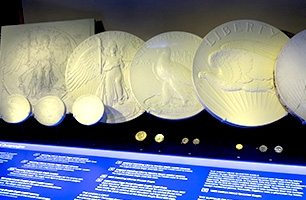
Sales Counters: Where to Buy Our Coins
You can buy our coins online 24 hours a day, but genuine Mint products are also sold at several locations around the country:
- Coin store at headquarters in Washington, DC. Current hours: 10 a.m. to 4 p.m., Monday through Friday. Closed federal holidays.
- Gift shop at the facility in Philadelphia, PA
- Gift shop at the facility in Denver, CO
A list of linkable tags for topics mentioned on this page.
- Mint History
- Privacy Policy
- Terms of Use
- Accessibility
© United States Mint All Rights Reserved.

Welcome to the revitalized FieldTripFactory.Org!

Featured Field Trips
Big al's aquarium supercentres.
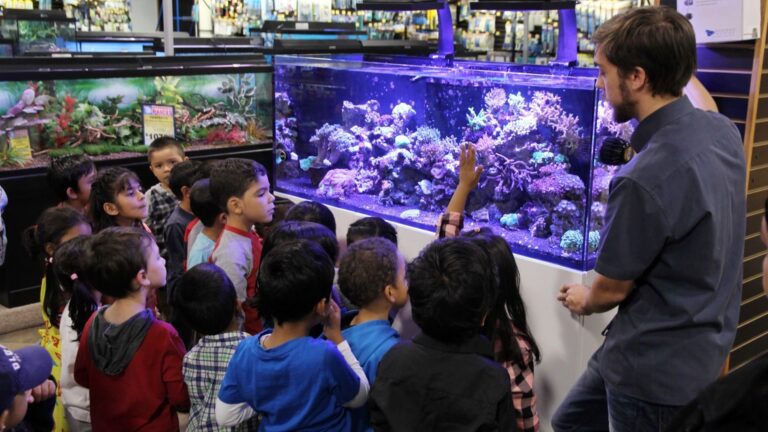
- 8 Locations - Canada
Jr K-8th | Special Needs
Izzy the Adventurer at Giant Eagle
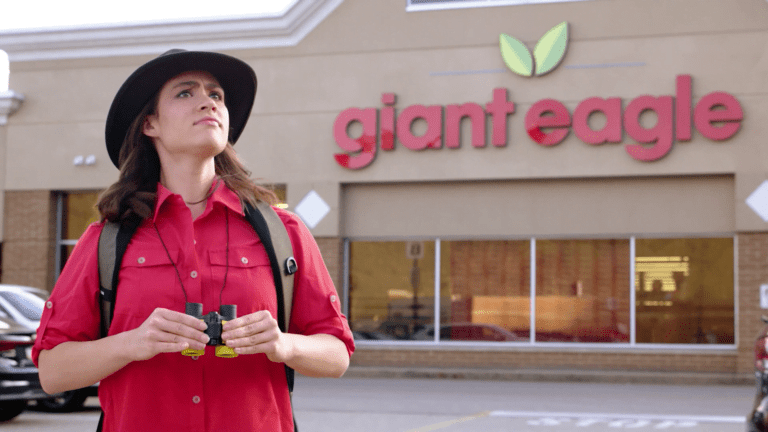
- Online Experience
PreK-3 | Special Needs
The ComEd Powering Lives Community Center

- Chicago, Illinois
Gr 6-Adult | Special Needs
Coming in 2024
We're just getting started!
- More programming
- More resources
- Add your field trip
- ... and even more!
Got an idea?
We'd love to hear your ideas on programs and resources to add! Send us your thoughts on our contact form...
VIP alerts!
Sign up for our email list and we'll be sure to let you know when new programming and resources are available!
Our Services
Design + development.
We've been helping organizations and businesses connect with the communities they serve for over 30 years.
Scheduling + Booking
Our cloud-based scheduling system keeps booking orgs and location staff aware of what's going on at all times.
Outreach + Awareness
We've built an ever-growing network to get field trips seen and heard in the communities they serve.
Community + Staff Support
Our Community Support Team is ready to help booking organizations and location staff via phone, chat, and email.
- Helping connect organizations to the communities they serve for over 30 years....

In-Store Field Trips at Giant Eagle are Currently Unavailable
What can you do?
- Add your name to our Email Sign Up (up top page nav)
- This will ensure you get notified when new programming in your area (including Giant Eagle) is added or restarted
- Enjoy the new ‘ Izzy the Adventurer ‘ online content provided by Giant Eagle which is free, on-demand, and includes activities!
FieldTripFactory.Org is constantly working to add new programming and restart old favorites!
Change Location
Find awesome listings near you.
Share This Post
70+ of denver’s best field trips.
While the kids might be at home learning online, it doesn’t mean you can’t get out for a stimulating field trip. Denver takes education to a higher level with endless outdoor adventures, interactive games and world-class cultural attractions. Where else can you track dinosaurs, check out Egyptian mummies, see vivid street art, hike around sandstone monoliths and take a treetop zip-line tour? The city also has plenty of sensory-friendly experiences. Visit Denver has compiled this amazing resource!
NATURE AND SCIENCE
Denver is surrounded by natural wonders and diverse ecosystems, providing the perfect classroom for budding scientists.
Run wild at the Denver Museum of Nature & Science and find everything from dinosaurs to Egyptian mummies, now featuring two new exhibitions: The Art of the Brick, famous artworks made out of LEGO® bricks, and Dogs! A Science Tail, an interactive look into what dogs are thinking; go on a safari at Denver Zoo, featuring the latest exhibition, Nature Connects®, Art with LEGO® Bricks with giant plant and animal sculptures ; swim with sharks and pet stingrays at the Downtown Aquarium; learn about Colorado’s ecosystems at Denver Botanic Gardens; go on an inspiring aviation tour, including the Wings Over Rockies Air & Space Museum; see rescued lions, tigers, bears and wolves roaming freely at the Wild Animal Sanctuary; look for rare black-footed ferrets at Rocky Mountain Arsenal National Wildlife Refuge; track dinosaurs at Dinosaur Ridge; see if you can spot bison at Buffalo Herd Overlook; explore the vast world of invertebrates in a rain forest setting at Butterfly Pavilion; and don’t forget the dog thanks to these pet-friendly hotels and parks.
OUTDOOR ADVENTURE
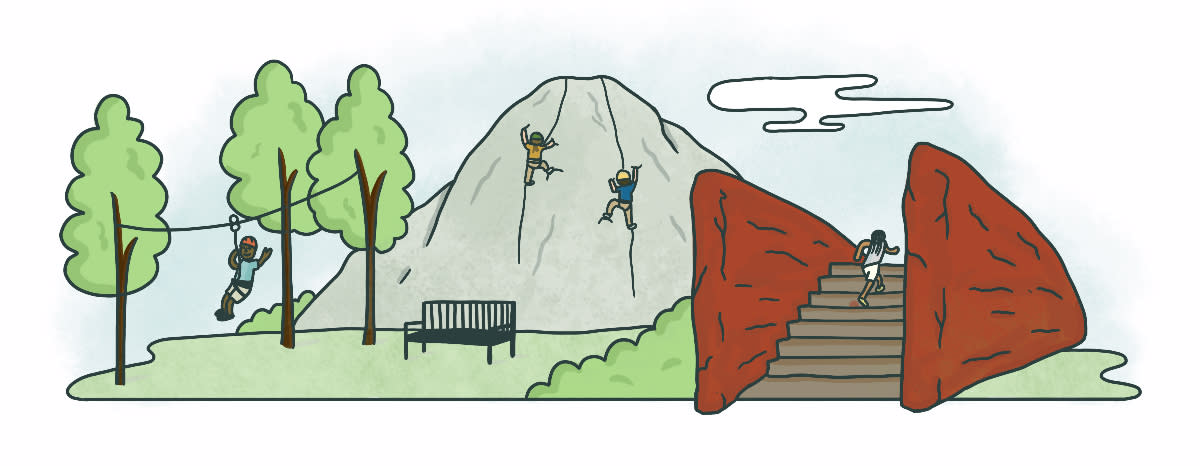
Denver’s year-round outdoor playground needs no introduction. But here’s a cheat sheet on how to get some fresh air and pick up valuable skills.
Go for an easy bike ride along the beautiful South Platte River that runs through downtown by renting a bike through Confluence Kayaks or take a tour with Mile High Bike Tours (ages 11 and up and accompanied by an adult); check out the mile-high markers in the city that are exactly 5,280 feet above sea level; hang out in the green spaces like Washington Park with its two lakes, gardens and mountain views; go for a hike among the stunning sandstone monoliths at Red Rocks Park & Amphitheatre; learn to climb (all ages) on real Rocky Mountain cliffs only minutes from town with Denver Climbing Co.; and take an inspiring day trip to check out fall colors and historical sites. If adrenaline-fueled activities are your thing, Castle Rock Zip Line Tours lets you soar on 1.5 miles of zip line at speeds of up to 50 mph, take a treetop zip-line tour 65 feet above Clear Creek with Colorado Adventure Center, or do it all at Lawson Adventure Park & Resort where you can zip line, traverse granite cliffs (thanks to Colorado’s only private via ferrata), roll down the mountain inside a giant ball and finish your adventures by rafting on Clear Creek. You can also spend a night in either cabins or yurts and do it again the following day. Note: The adventure parks have minimum age and weight requirements.
HANDS-ON HISTORY

The city has a colorful past. These museums and cultural attractions provide exciting ways to get your hands on history.
See what it’s like to be a firefighter at the Denver Firefighters Museum; go back in time at Denver’s oldest house at Four Mile Historic Park; learn about the life and times of Titanic survivor Margaret Tobin Brown at the Molly Brown House Museum; take an inspiring African American heritage tour; watch history come alive at History Colorado Center with cutting-edge activities like a virtual ski jump; hear the stories behind some of the state’s most prominent women at the Center for Colorado Women’s History at Byers-Evans House Museum; see classic and unique cars, airplanes and trains at the Forney Museum of Transportation; take an unforgettable ghost tour or check out the haunted Cheesman Park; go on a self-guided history adventure via the Denver Story Trek; and take a train ride at the Colorado Railroad Museum.
FINE ART & STREET ART

Seeing famous artwork up close and creating your own through workshops is essential for developing the right side of the brain. Here’s how to bring out your best.
Get free admission to Denver Art Museum, known for its Indigenous art collection, every day for those under 18 and enjoy various activities and programs for kids; check out the Museo de las Americas , the premier Latin American art museum in the Rocky Mountain region; see large-scale works of one of the most important American artists of the 20th century at the Clyfford Still Museum (free admission for children under 17; the museum is temporarily closed until Sept. 18); see inspiring and challenging contemporary art at MCA Denver — Museum of Contemporary Art Denver (free admission for children under 18) with special programs for teens; take on all kinds of DIY projects from leatherworking to jewelry making at Upstairs Circus (recommended for ages 9 and up; minors must be accompanied by an adult); express yourself through various arts-based classes and workshops for all ages at The Art Garage; and see why Denver is becoming a mecca for street art with mind-blowing murals all over town. For more about the “Love This City” mural above, read the blog post about local artist Pat Milbery of So-Gnar Creative Division.
MUSIC, FILM & LITERATURE

Take a break from textbooks by diving into literature from locally owned shops or seeing a movie on the big screen. Here’s how to expand your world.
Enjoy a drive-in movie in the great outdoors; buy books at Tattered Cover Book Store or BookBar; take stunning images at these popular photo ops; take a comedy class for kids and teens at Rise Comedy; and get a glimpse of many of the big stars who’ve performed at Red Rocks Amphitheatre via the Colorado Music Hall of Fame (temporarily closed) located not far from the stage.
FUN & GAMES

Now it’s time for recess. You deserve some playtime!
Choose from five themed escape rooms for an unforgettable experience at EscapeWorks Denver; go bowling and play arcade games at Lucky Strike Denver; play various golf games and try the delicious food at Topgolf or play a round of mini-golf at Urban Putt; release some energy (and rage) by breaking various things at SMASH*IT Breakroom (must be at least 13); play board games at the Game Lounge; go on a scavenger hunt with Let’s Roam; spot hidden elves at the Denver Museum of Nature & Science; shoot at each other with foam-tipped arrows at Archery Games Denver (recommended for ages 10 and up; youth hours on weekend for those 7-12); throw axes, yes axes, at DAGAR (recommended for ages 10 and up); assemble a team and choose a mission in live-action escape rooms at Puzzah!; and create, discover and explore with unique exhibits and activities on nine acres at the Children’s Museum of Denver at Marsico Campus (newborns through age 8).
Download this PDF for your kids to record where they went and what they learned. Send a picture of your completed form to [email protected] so they can see where you went and tag your social posts with #fieldtripDenver.
Please check with local businesses and attractions individually before you venture out for the latest COVID-19-related policy updates and hours of operation.
Author: Mile High Mamas
Related articles.

Leave a Reply Cancel Reply
You must be logged in to post a comment.
Forgot your password?
Remember Me
No account? Sign up
Lost Password
Please enter your username or email address. You will receive a link to create a new password via email.
Already have an account? Login instead
- FAQs/Contact

Freedom Homeschooling
20 ways to save money on homeschool field trips.
by Freedom Homeschooling | Jan 5, 2023 | Field Trips , Free Printables

Field trips provide hands-on learning experiences and are lots of fun too. However, taking field trips can be challenging when money is tight. Fortunately, there are many ways to save money on homeschool field trips! Here are some ways I have found.
Every Kid Outdoors
Every Kid Outdoors is a program sponsored by the National Park Service that gives U.S. fourth graders and their families free admission to over 2,000 federal parks, lands, and waters. If you have a fourth grader in your family, print your free pass here .
Museums for All
Through Museums for All, individuals receiving food assistance (SNAP benefits) can gain free or reduced admission to over 1,000 museums throughout the U.S. by presenting their EBT card. Museums for All’s website provides a searchable directory of participating museums.
Local Businesses
Ask around in your community, and you will likely find that many business owners are willing to offer tours and share about what they do. We have toured a veterinary hospital, a honey bee farm, and other businesses with local homeschool groups without paying anything. Additionally, Factory Tours USA lists factories that offer tours, many of which are also free.
Community Services
Learning about community services is another great way to take a free field trip. Homeschoolers in our area have been able to tour fire departments, the public library, the recycling center, and the mayor’s office.
Explore Nature
Explore nature and get exercise with a free family outing to the beach, a nature trail, or even a walk down a country backroad. You could also add geocaching or a scavenger hunt for more fun.
Free Museums
Google “free museums” in areas around where you live. I’ve found that most cities usually have at least one free museum. The most common type of museum to offer free admission seems to be art museums, but I have also found other types.
Homeschool Discounts
Group discounts.
Many places will offer discounts to groups over a specific number. Organize a field trip with a group of friends or a local homeschool group, and everyone will get to save on the field trip.
Discount Days
Some popular field trip destinations offer reduced admission on certain days of the week. For example, a zoo in our area offers half-price Tuesdays. Your family can save a lot of money on homeschool field trips by planning your outings on these days.
Seasonal Passes and Annual Memberships
Consider purchasing a seasonal pass or annual membership to places your family would like to visit frequently, such as a local nature park, zoo, or science museum. These memberships often don’t cost much more than purchasing day passes twice.
Home Improvement Stores
Lowe’s offers DIY-U Workshops for kids, and Home Depot provides Kids Workshops . Both programs offer a free craft or project kit and an in-store class. For a schedule and to register, see the stores’ websites. You may also want to check with other home improvement stores in your area to see if they offer classes or field trip opportunities.
Churches and Places of Worship
Many churches sponsor free or low-cost events for the community. This could include fall festivals, musical performances, missionary fairs, food festivals, and more. Additionally, some historic churches offer free tours.
Community Events
Free community events are another great way to save on homeschool field trips. Often cities or non-profit organizations will sponsor free events. Keep an eye out for these on local news websites and social media. What’s available will vary by area, but these can include things like cultural heritage events, musical performances, outdoor summer movies, and holiday events.
Library Events
Libraries aren’t just for borrowing books. Many libraries offer things like storytimes, crafts, and various educational events and presentations. These programs are especially common during the summer months when school is out.

Volunteer Opportunities
Volunteering is an excellent way for your family to take a field trip while giving back to your community. Volunteering can also be a way for older kids to gain work experience and skills. Check around in your area to find out which organizations allow children to volunteer.
Colleges and Universities
Touring college and university campuses isn’t just for teens making a college decision; it can be a fun learning experience for the entire family. Many campuses feature historical buildings and museums. While these museums aren’t usually free, they are often lower-priced than other field trip options. Also, keep an eye out for community and educational events sponsored by colleges in your area.
Groupon and Other Discount Websites
Websites like Groupon often sell discounted tickets to events and attractions. It can be hit-or-miss, but it’s worth occasionally browsing sites like these for deals that could save your family money on homeschool field trips.
Credit Card Perks
Some credit card companies offer free or discounted tickets as a perk to their customers. One example of this is Bank of America’s Museums on Us program. This program provides free general admission to cardholders, during the first full weekend of every month, to over 225 museums across the U.S. If you have a credit card, check to see if they offer a similar program.
Travel Off-Season
Planning a big trip? If you are planning on traveling out of town for a longer field trip, try to plan it during the off-season rather than peak travel times, especially if the area is a popular tourist destination. Not only will lodging and other expenses be less expensive, but the places you visit will also be less crowded than during peak travel times.
Virtual Field Trips
If field trips aren’t possible at all right now because of a lack of transportation, illness, or other constraints, you may want to try a free virtual field trip instead. Virtual field trips allow your family to explore the world without leaving home.
Free Printable Field Trip Journal and Log
Before you head out on your next field trip, be sure to print our Field Trip Journal and Log. This 7-page printable set includes pages for your kids to record the details of their field trip, including where they went, what they did, what they learned, and more. You could even compile the field trip journals from every field trip your family takes this year into a binder to create a field trip memory book. The printable set also includes a field trip log for your child to keep a record of every field trip and their rating of each one.
>>> Click here to grab your free printable Field Trip Journal and Log. <<< Simply enter your first name and email address in the form and opt-in to receive our free newsletter. As a thank you for subscribing, you’ll receive this PDF freebie in your inbox within moments. If you’re already a subscriber, enter your information in the form, and we’ll be glad to send the printable to you too. Don’t worry; you won’t receive duplicate newsletters from us.

I hope your family has lots of fun-filled field trips this year!
At the Freedom Homeschooling Blog, you'll find homeschool resources and information, tips for homeschooling on a budget, encouragement, and more! Follow us on Facebook, Pinterest, Instagram, and Twitter, so you never miss a post.

May Freebies
- May Unit Studies
- Mother's Day Unit Study
- Printable Bird Watching Journal
- Printable Camping Journal
- Color Mixing Printables
- Printable Field Trip Journal


Fun Year-Round Field Trip Ideas for Homeschoolers Right In Your Backyard
The Fervent Mama uses Affiliate Links. See our disclosure policy here .

The cool est thing about homeschooling is that it provides so many opportunities to structure and learn in locations outside of the home and away from the traditional classroom settings.
While the content and lesson planning is important for the day-to-day of homeschooling, there’s some wiggle room in deciding what places to take educational field trips throughout the duration of the year.
With public school settings, there are often restrictions and different loop-holes to have to jump through to plan and schedule a field trip.
But with homeschooling, you have the flexibility to schedule trips to locations that fit with you, your curriculum, interests, and even your lesson plans!
If you are needing some ideas about year-round fun field trip ideas for homeschoolers , here are some simple suggestions to help get you started!
Take these Notebooking Pages with you on your field trips!
Any time you want a special thematic paper for a writing assignment, writing a letter, journaling, or sending something to a loved one, this notebooking pack is the perfect solution.

Year-Round Homeschool Field Trip Ideas
Homeschooling provides opportunities to structure and learn in locations outside of the home and away from the traditional classroom settings. While the content and lesson planning is important for the day-to-day of homeschooling, there’s some wiggle room in deciding what places to take educational field trips throughout the duration of the year.
With public school settings, there are often restrictions and different loop-holes to have to jump through to plan and schedule a field trip. But with homeschooling, you have the flexibility to schedule trips to locations that fit with you, your curriculum, interests, and even your lesson plans!
If you are needing some ideas about year-round fun field trip ideas for homeschoolers, here are some simple suggestions to help get you started!
Public library
Your local library is open all year long, and it’s likely full of amazing activities and educational opportunities. Not only is a weekly trip to the library fun to be able to just grab new books, but take it a step further and see what type of programs your library offers as well.
Many libraries have special speakers, children’s activities, and classes that they offer during the week that are free and open to the public.
It could also be a great place to meet new friends! Libraries usually have other homeschool moms that meet there and have a co-op group lesson as well!
If you have a zoo in your vicinity, what are you waiting for? It’s full of fun animals to view, and your children will be able to read the signs about the animals and learn a ton of great facts that they are sure to talk about for many days to come!
Most zoos are open throughout the year and also make accommodations for colder weather temperatures.
If you’re heading out to the zoo soon, or if you’ve already been, try adding our Zoo Animals PreK Workbook to your curriculum for some added fun! It’s full of lessons and coloring pages that have lots of animals that you’re sure to see on your trip!

Planetarium
Many major cities have a planetarium available and open to the public. If so, this field trip must happen! So many educational topics are played and discussed and it is such an amazing opportunity to open your children’s eyes to the wonders of the world.
Many YMCAs have activities for children to participate in. Whether it is day camps, summer activities, or even swimming lessons- see what your local YMCA offers to the public and if it may be something that your child is interested in!
If you don’t have a local YMCA, you can still visit any type of workout/kid-friendly recreational center. If you are learning about the body and the importance of being active, why not take a fun trip to a local gym and let your child experience different work-out options first hand?
Many gyms offer a trial period, but you could even talk to the manager about a homeschool experience or homeschool pricing structure for repeat visits.
Roller-skating rink
Because sometimes, field-trips can be just for fun as well! We can write it off as Physical Education, right?
Local Paper
If your local newspaper allows for visitors, don’t skip out on the opportunity to schedule a shadow project and tour. You may be able to follow around a journalist or watch the printing process!
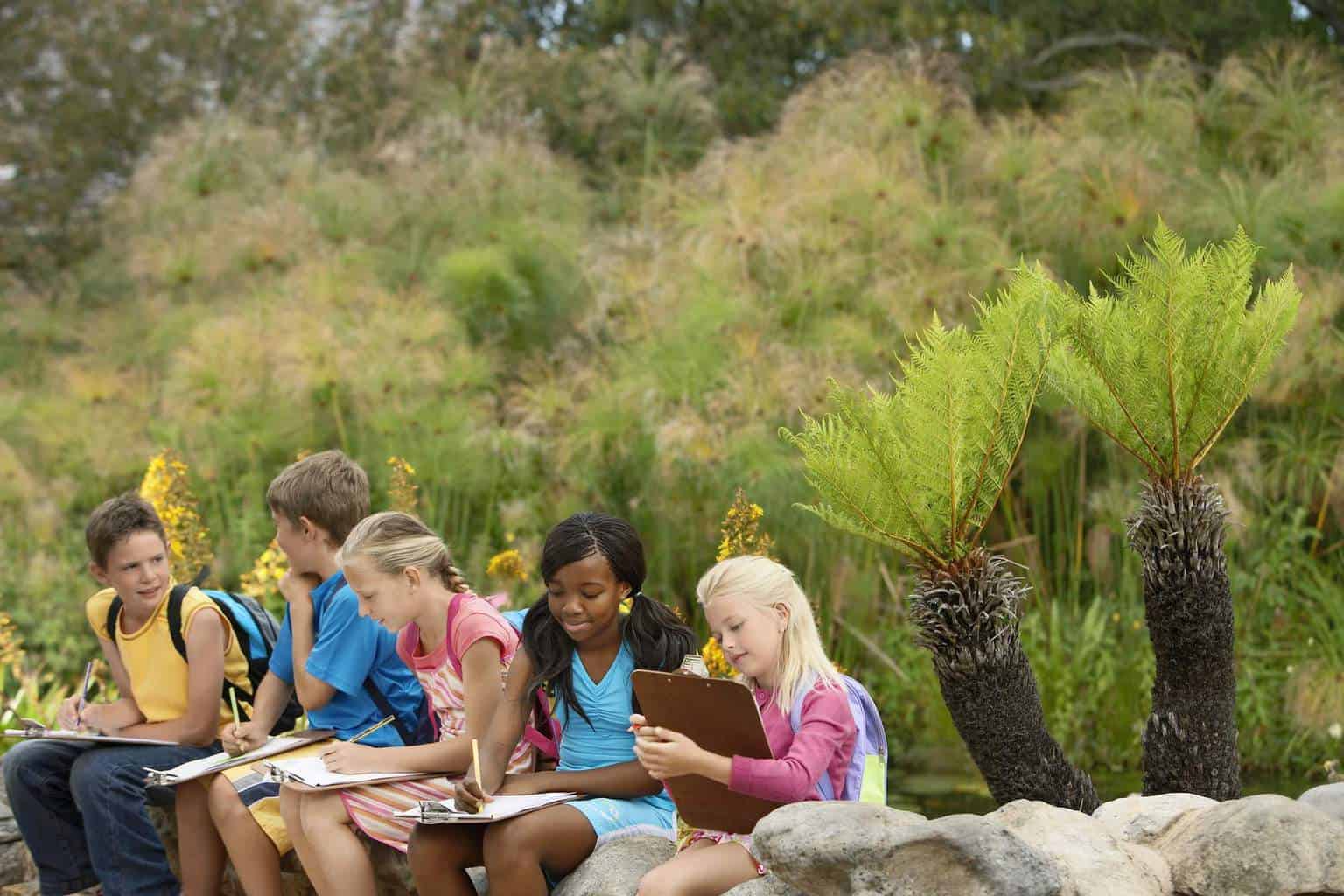
Not all towns have a local aquarium, but you may be able to find an area that is close enough to make a day trip out of it!
Aquatics is such an amazing thing and learning about a part of the world around us that we don’t get to see often is a great learning experience.
Science, Children’s, Art- is there a museum that’s close enough to drive to in your area? Don’t count these opportunities out!
Farm, Nursery, Greenhouse
Finding a local farm, plant nursery, or greenhouse garden is a perfect opportunity to learn about where our food comes from and how it gets to us.
Locally-Owned Restaurants and Bakeries
Do you have a student who wants to be a chef, food critic, or restauranteur? Contact your favorite local restaurant or bakery and see if their chef/owner would be willing to give you a tour, talk about the workings of the business, or do a private cooking class.
Small business owners are usually very proud to share their insight with community locals- especially children and it serves as one of the fun field trip ideas for homeschoolers without them realizing it!
Local Factory
Maybe there’s a local automotive, beverage, lumber yard, or something similar that your town is proud of. If so, contact their customer service department to see if they offer homeschoolers the opportunity to come and tour the place.
These are usually special experiences because they are smaller groups than the regular public school field trip requests!
Did you know that a lot of hospitals will put together a tour if you ask? If you have a budding doctor or medical professional, this could be an amazing experience to see what our unseen heroes go through on a daily basis!

If you are fortunate enough to live in an area with a state park, take advantage of what it has to offer. Go on nature hikes, stream wading, or other adventures.
Be sure that you join in on the adventure too and teach your kids a classic like how to skip rocks!
Don’t forget to check with the local park ranger! State Parks often offer many different classes and activities geared towards children learning about the wildlife and nature that are free to attend and highly educational!
Police Department
It’s important for our children to know and understand the importance of our police and justice system. Call your local police station and organize a trip down to the local police department.
Be sure to ask if they can ask any questions, maybe take a tour, or even take a ride in a police car!
Fire Station
Fire Station tours are the best. Not only do they get to learn how to handle and react in an emergency, but oftentimes they get a tour of the building, learn how the staff works together as a team, go on calls, as well as the workings and functions of a fire truck.
Both adults and children will love this experience!
Community Garden
If your town has a community garden, it’s an excellent resource for your homeschool classroom. You can learn about gardening, help water and care for the plants, and maybe even get to nibble and taste some of them fresh from the garden!
Talk about a hands-on learning experience for you and your child and you’re giving back to the community too! It’s great to visit the garden at different seasons throughout the year because plants grow in different types of weather.
This is definitely one of the more lasting fun field trip ideas for homeschoolers that allow for learning and excitement!
Television Station
If your local news station has an active presence in the community, call them and see if they would be willing to allow a small group of homeschoolers to tour/visit.
Your kids will have the opportunity to learn about why the news is important to the community and maybe even a weather lesson!

Fun Year-Round Homeschool Field Trip Ideas Right In Your Backyard
Field-trips are a ton of fun, no matter what time of year they are taken. Think of places around town that are of interest to your children, and then contact and see if a field trip could possibly be an option.
You may be surprised by how many locations are thrilled by the idea of showing you and your crew around!
Do you often book field trips for your home learners? What are your favorite fun field trip ideas for homeschoolers?
If you’re looking for a great community of Christian Homeschoolers, we want to invite you to join our Facebook Group, Fervent Christian Homeschoolers ! It’s a great place for you to meet other women who share the same passions of raising our littles to love Jesus!

Leave a Reply Cancel reply
Your email address will not be published. Required fields are marked *
This site uses Akismet to reduce spam. Learn how your comment data is processed .
- Join for free
- Why Innovation Learning?
- What is Model i?
- What is The Henry Ford?
- Our Partners
- In the Press
- Innovation Atlas
- Teacher Innovator Awards
- Educators-in-Residence
- Invention Convention Curriculum
- Innovate Curriculum
- Innovate for Tots
- Model i Primer
- Virtual Field Trips
- Invention Convention
- Field Trip Information
- Summer Camps
- Field Trip Reservations
Field Trip FAQs
Need Assistance? Call our Contact Center representatives, Monday-Friday 9 a.m. until 5 p.m., Saturday & Sunday hours vary seasonally or email [email protected].
How many students and adult chaperones do I need to qualify for a field trip?
A minimum of 10 students is required to obtain the discounted rate.
One adult group leader is required for every 10 students, grades K-12. To ensure appropriate supervision, we will provide your group with one free teacher/chaperone ticket for every 10 students. Additional adults or teachers will be charged the $10 school group rate. Free teacher/chaperone tickets only apply to Greenfield Village, Henry Ford Museum of American Innovation and Ford Rouge Factory Tour visits.
What are your hours?
The Henry Ford Museum of American Innovation is open daily from 9:30 a.m. until 5 p.m. Greenfield Village and Ford Rouge Factory Tour hours vary seasonally. See thf.org for more information on hours.
What is the school group rate?
Rates rates are $14 for Greenfield Village, and $12 each for Henry Ford Museum of American Innovation and Ford Rouge Factory Tour. The rate is the same for students and adult chaperones. A minimum of 10 students is required to obtain the discounted rate. In order to ensure an appropriate student-to-adult chaperone ratio, The Henry Ford will provide one complimentary ticket for the Greenfield Village, Henry Ford Museum of American Innovation and the Ford Rouge Factory Tour for every 10 students booked on the field trip.
Does my group have to arrive together?
Do you have eating facilities for groups.
Yes, we have a student dining area located in Henry Ford Museum of American Innovation. This area can be reserved in 15-minute increments, can accommodate up to 200 people and is free of charge. There are vending machines for cold beverages only, located in the dining area. Greenfield Village has numerous eating areas which are on a first-come, first-served basis.
Please note that eating areas in Greenfield Village are unsheltered.
What options do you have should my students wish to purchase their lunches?
We do have restaurants onsite, however, we STRONGLY recommend bringing lunches as it will save time and money. Our on-site restaurants in the Henry Ford Museum of American Innovation include Plum Market Kitchen. In Greenfield Village, we have A Taste of History Restaurant, among others (hours vary by location and season).
Do you have a place for us to store lunches?
We recommend chaperones bring backpacks to hold lunches or bring your own wagons as we have a very limited amount of lunch wagons. They are available on a first-come, first-served basis.
How many adult chaperones do you require?
What is your payment policy.
Henry Ford Museum of American Innovation and Greenfield Village admission can be paid upon arrival but must be reserved in advance. For speedier service, we suggest paying in advance so that tickets will be printed and ready for pickup. We can also mail tickets directly to you for a small fee if we receive payment at least three weeks prior to your visit. The Ford Rouge Factory Tour and Giant Screen Experience Films must be paid three weeks in advance.
Do I have to purchase my tickets in advance for Henry Ford Museum of American Innovation or Greenfield Village?
You have to reserve your tickets at least 24 hours in advance to receive school group rates and services, but you do not have to pay for them in advance. However, we highly recommend advance payment. If your tickets are prepaid, you may avoid long admission lines.
Where do I check in?
Our Contact Center Group Services coordinators can advise you on available check-in locations. This information is also indicated on your confirmation under the heading of "Delivery Method." Group Check-In will be available at the Greenfield Village Ticket Building and Clocktower Entrance of the Museum. (Check in location is based on your reservation, please see confirmation email with pick up location)
What methods of payment do you accept?
What if i have extra greenfield village and henry ford museum of american innovation tickets.
Excess tickets can be returned to the Contact Center Group Services team for a full refund.
How much are the rides in Greenfield Village?
Ride Duo tickets that include one ride on our Steam Engine Locomotive and one ride on our Carousel are $7/person. All day train tickets are $5 for school groups.
What can I expect to see on the Ford Rouge Factory Tour?
Can i take my own bus to the ford rouge factory tour, do home educators receive a discount on memberships to the henry ford, explore even more resources, field trips, scholarships, curriculum resources, professional development.
A Community Built by Educators for Educators
Help prepare all learners to be world-changing innovators, inventors & entrepreneurs.
Integrate Innovation Learning into Your Classroom
Learn more about workshops and experiences designed just for educators.
Resources that Activate an Innovative Mindset
Connect core disciplinary understanding to the real-world.
Take Learning Beyond the Classroom
Introduce them to iconic inventions, inspiring individuals, and unique settings that have changed the world.
Due to site maintenance, some areas will be unavailable starting at 12 a.m. EST on May 10th.
We're sorry. our online payment is currently down. please check back later to place an order for pickup., kids learn a healthier way to shop.
For nearly 20 years, Giant Eagle® has teamed with the Field Trip Factory to educate local students about healthy living and nutrition.
Through field trips to your neighborhood Giant Eagle store, the Be A Smart Shopper! program encourages children to become passionate about healthy diets and lifestyles by learning:
- How to make health-smart choices while grocery shopping
- How to plan well-balanced meals using the food groups
- How to read nutrition labels and determine portion size
- The important benefits of vitamins and minerals
- Basic food safety
- the benefits of exercise and staying active
Students learn important life-skill nutrition lessons in a fun and real-life environment through the use of hands-on activities and discussion. Designed for Preschoolers to Middle Schoolers Geared for children ages 5 to 12, the Be A Smart Shopper! tour includes two programs to accommodate students in Pre-K to Grade 3 (approximately 60 minutes) and Grades 4 to 6 (approximately 90 minutes). Best of all, the programs are FREE! For teachers and homeschoolers alike, the Be A Smart Shopper program is a perfect supplement to lessons on health and nutrition and aligns with STEM (Science, Technology, Engineering and Mathematics) standards. Plus, Girl Scout and Boy Scout troops can use the program towards requirements for merit badges.
Schedule A Field Trip Field trips must be scheduled in advance and are typically limited to 30 participants per tour. For more information or to schedule a field trip, call 1.800.987.6409.
Field Trip Factory Field Trip Factory brings lessons on a variety of subjects, such as the arts, nutrition, the environment and animal welfare, to life by providing hands-on activities in real-world environments. Participants experience learning close to home and in a context relevant to their daily lives. Visit Field Trip Factory to learn more.
How a migrant farmworker built generational wealth, penny by penny
My grandfather kept ledgers logging every day he worked in the u.s. the dry entries — “18 boxes of cherries, $4 per box” — tell a story of success against the odds..
- Show more sharing options
- Copy Link URL Copied!
My grandmother told me about the missing notebook.
It had a blue cover, she said, and was unmarked except for “ cuaderno de trabajo ” written in the italicized superscript taught in elementary schools around Mexico. Kept by my grandfather when he labored on farms and orchards in the United States, the notebook recorded where he had worked, how much money he earned and — most important — where that money went.
The problem, my grandmother said, was that the “notebook of work” probably had been destroyed or thrown out. My grandfather, a man of few words, didn’t know where it was either.
But what if that notebook wasn’t gone?

After graduating from college in 2023, I traveled to the Mexican state of Oaxaca to visit relatives and to report on the effects of remittances sent back to Mexico. I was unable to find old bank records or receipts, but my grandmother mentioned the missing notebook one night after dinner.
I knew I had to see it to learn more about my family’s history, so I went to the last place Herminia Rodríguez Andrade remembered having seen it: the village where she and my grandfather, Pedro Martínez, were born in the 1940s and started a family.
Inside the two-room adobe house where the couple and their eight children once lived as subsistence farmers, I sifted through photographs and utility receipts filling a cardboard box that sat next to the only bed. At the bottom, I found it: a Mead brand spiral-bound notebook. The front cover nearly fell off when I opened it, revealing page after page of entries that were dry, even monotonous.
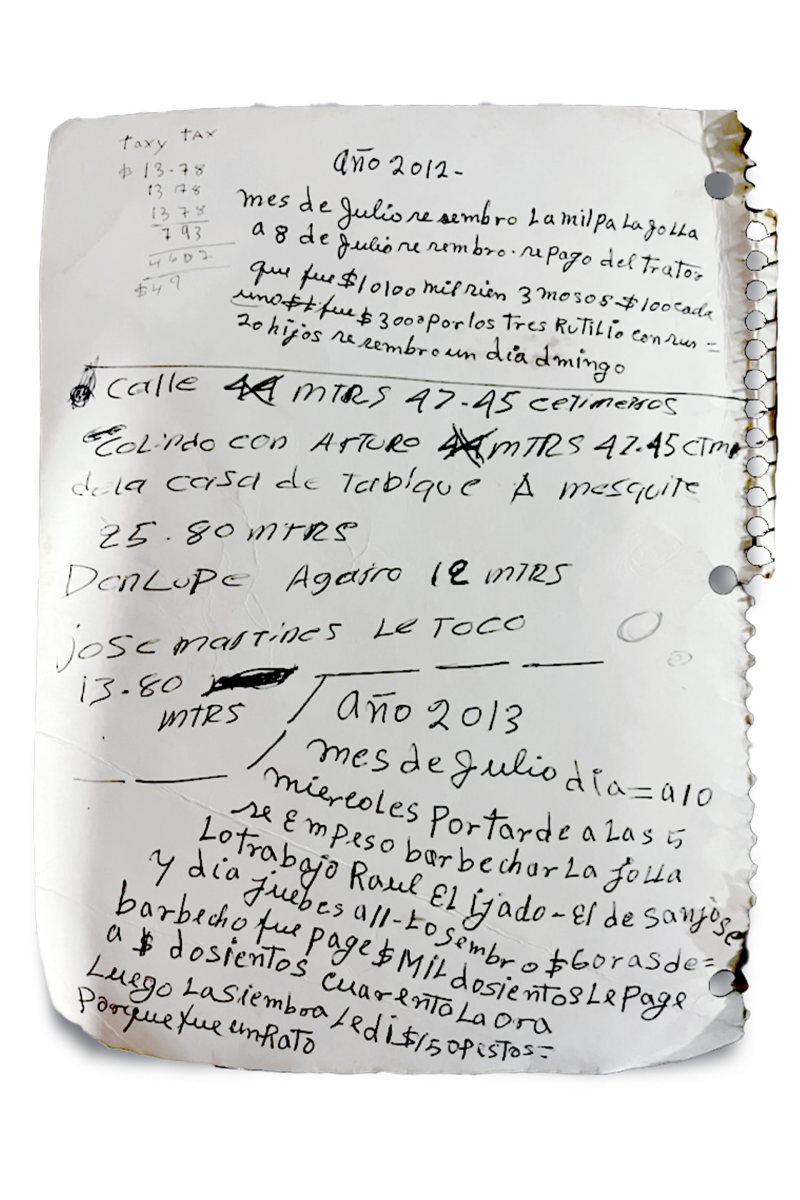
“October 3, Friday. Eight hours laying wire with Enriquez.”
“November 21. Friday. Eight hours pruning pears. Pruning started today.”
“December 5, Friday. Eight hours pruning apples with Eri.”
Page after page, line by line, I saw how Pedro lived and worked in 2008 and 2009 in the orchards of central Washington. They traced every job he had and even indicated the days rain cut a workday short.
The notebook was the first of about a dozen ledgers that I would find in the adobe house and at the family’s current home in Huajuapan de León, a Oaxacan city of 80,000.
Pedro often recorded what he earned, as in this entry from 1999: “July 22, Thursday. 18 boxes of cherries. $4 per box.”
He also recorded the day he made nothing at all. Using an X to indicate zero, on July 26, 1990, Pedro wrote, “X because there was no work.” Some weeks had lots of Xs. The last entry from that year, in November, reads, “On Thursday I left for Mexico at 5 a.m.”
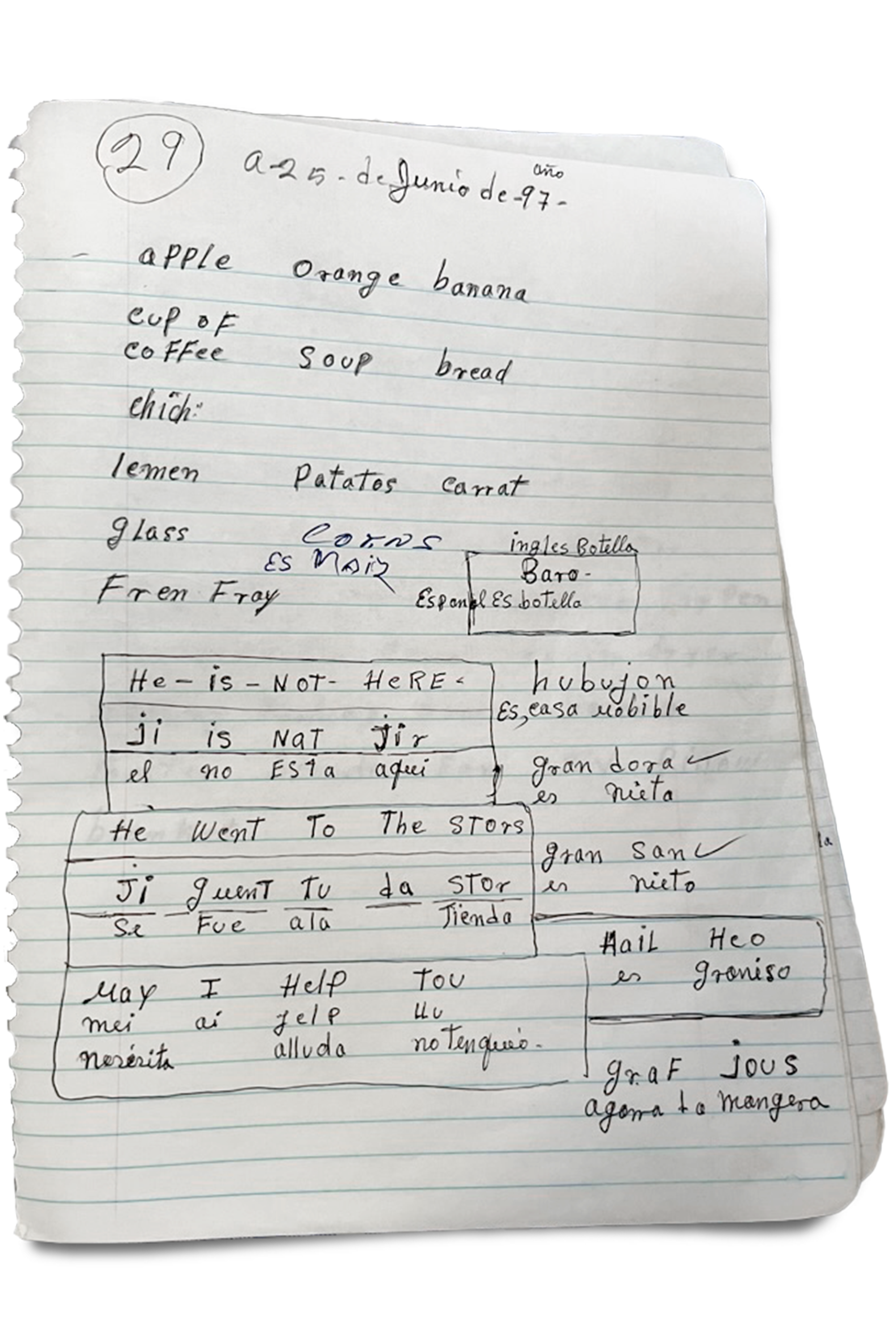
With entries from California, Oregon and Washington state, the books were kept to document the transfer of money. Now, in a larger sense, they tell the story of how remittances sustain life in Mexico. Over time, remittances provided a source of modest generational wealth for my Mexican grandparents, aunts, cousins, nieces and nephews — to the point where my American family no longer feels the need to send money, except in times of emergency.
The notebooks capture pieces of Pedro’s life, work and aspirations from 1981 to 2010, when he returned to Mexico for good. They are far richer than any bank records.
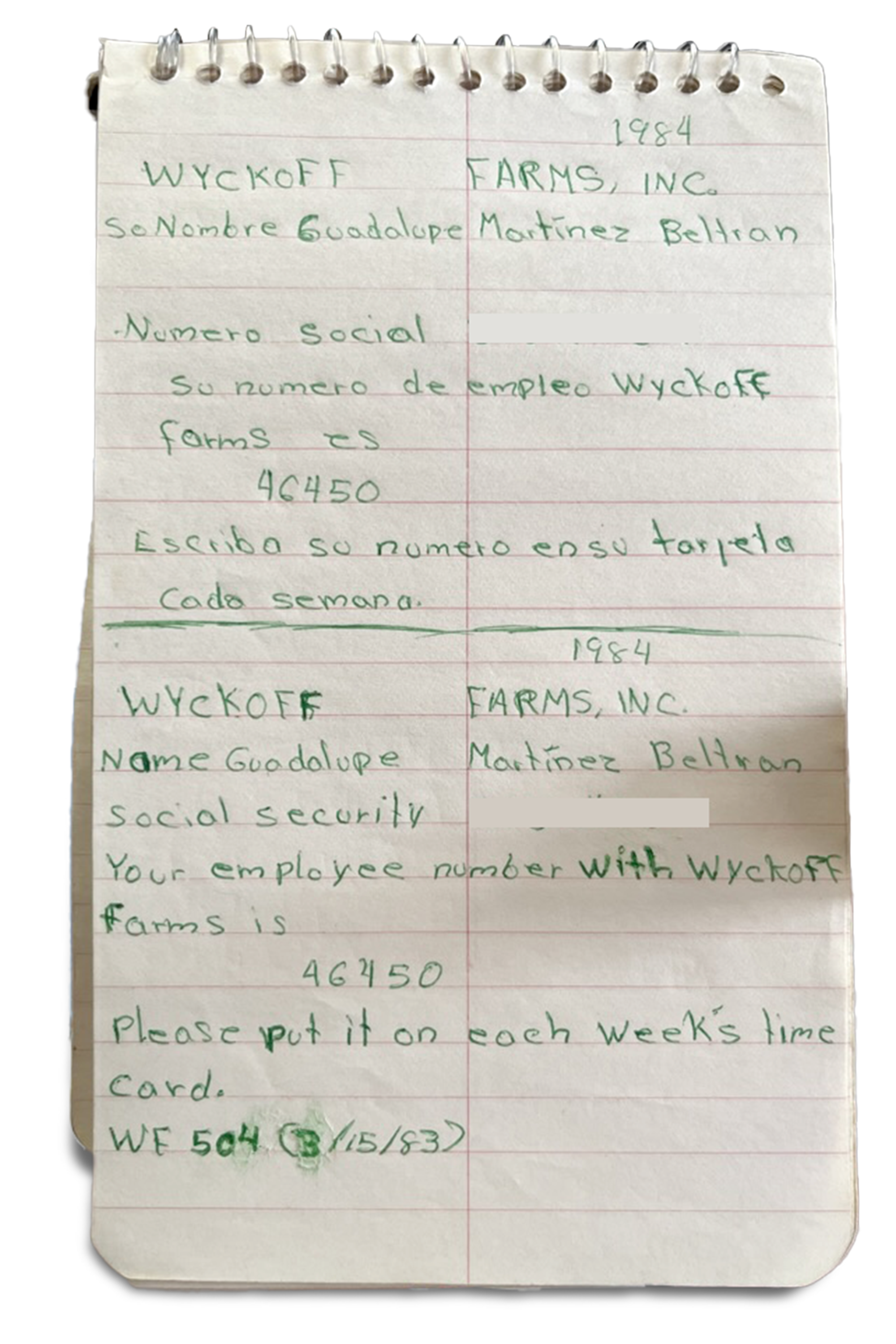
Sometimes, Pedro drew sketches of the house he planned to build in Huajuapan someday. It would have six rooms across two floors, with windows along the north side.
Other times, he wrote English phrases that he copied from paperwork or learned from classes in the United States: “Your employee number with Wyckoff Farms is 46450. Please put it on the card.” He also wrote down “cherry,” as in “18 cajas de cherry ,” instead of the Spanish “cereza.”
Pedro’s notations, though repetitious and even tedious, opened my eyes to his meticulous nature, the way he viewed each dollar as one that couldn’t fall through the cracks.

Money sent from the United States plays an oversized role in the economy of rural Mexican states. In Oaxaca, home to more than 4 million people, residents collectively received $2.9 billion in remittances in 2022 — equal to about 12% of the state’s gross domestic product, according to the Bank of Mexico and government figures.
For many recipients of remittances, the funds are used to fill gaps in social services and to supplement a minimum daily wage of 207 pesos, or roughly $10.
More than 80% use the transfers for basic needs such as food and clothing, according to the bank BBVA , while fewer than 15% use the money for education. Even fewer use it to buy land, another way in which my family is an exception.
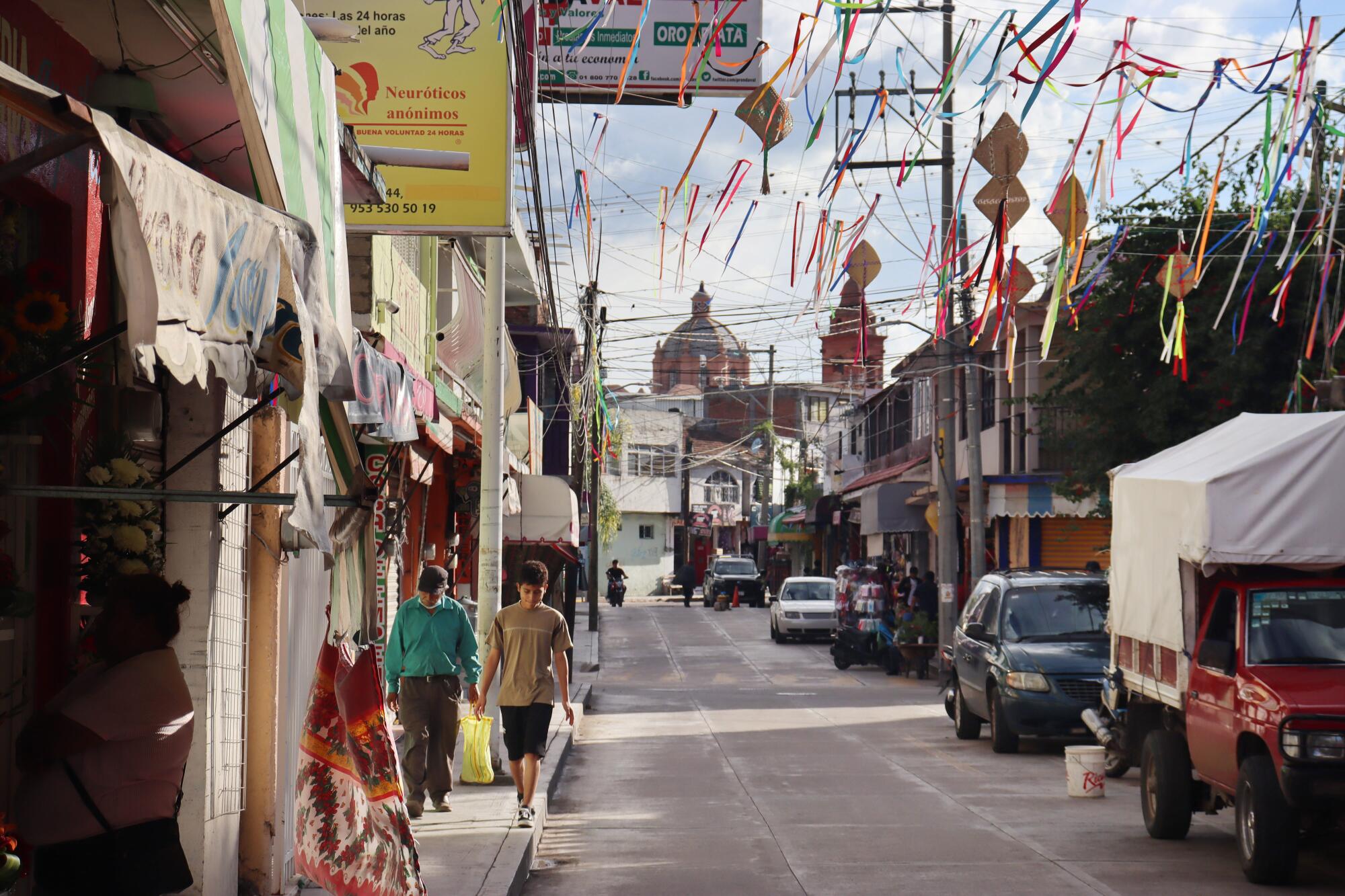
Since the money is often not invested in something that could ultimately generate income or promote development, like starting a business, its long-term impact is limited, said Jose Ivan Rodríguez-Sánchez, a research scholar at Rice University’s Baker Institute Center for the United States and Mexico.
Generally, he said, people stay poor.
But in my family, remittances have been used for decades as a pathway to upward mobility.
And it all began, as with the notebooks, with envelopes always bearing three stamps.

March 12, 1992: Sergio Martinez sent $200, worth 600,000 pesos
Growing up in Wenatchee, a small city in Washington state known as “the Apple Capital of the World,” I knew the importance of remittances from weekly trips to the tienda mexicana . There, my dad, Sergio, would buy telephone cards and call his parents, Pedro and Herminia, to check on the family or confirm they received the money he’d sent.

I knew that my grandparents grew up the way most rural Mexicans did in the 20th century: extremely poor. I knew that poverty led Pedro to follow a gushing stream of laborers from Mexico to chase farmwork in the western U.S. Pedro drifted from San Diego County to Oregon’s Willamette Valley, until he found a job he liked picking fruit in arid central Washington.
A showcase for compelling storytelling from the Los Angeles Times.
But there’s a difference between stories passed down and truths I could learn as a journalist. It was only while reporting in Huajuapan that I understood the coordination it took to save my relatives from food insecurity and the discipline it took to avoid using newfound wealth for unnecessary purchases.
When Pedro first crossed the border without documentation in 1978 to pick strawberries in Escondido, he lived in a tent on a patch of flat dirt near the farm where he was working. Intent on saving almost every dollar of his pay for his return to Oaxaca, he ate wild cactus he harvested from the hills, recalling that they were “different — no, worse — than the cactus at home.”
On his first trip home, Pedro brought an envelope thick with cash. It was the largest sum of money the family had ever deposited in a bank at one time: $3,600.
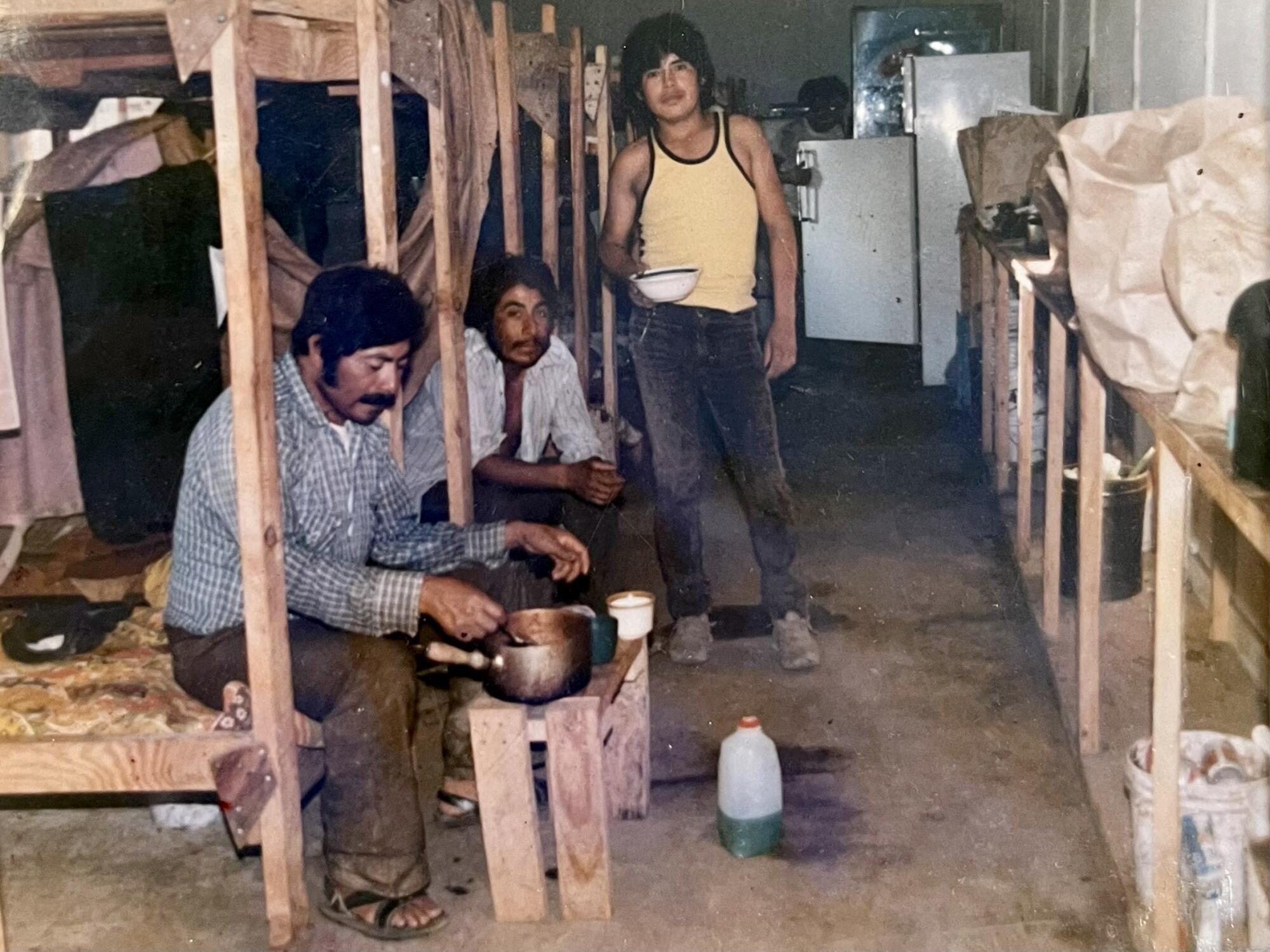
As detailed in the notebooks, that sum was the result of months of modest accumulation: $100 on a good day, when his wages were above $4 per box of fruit picked and he could fill more than a dozen boxes; less than $50 on others, when the dry summer heat made it unsafe to continue work in the afternoon.
After returning to the United States, he began to send home cash in monthly envelopes — always using three stamps to ensure prompt delivery. Herminia and her young children would pick up the mail and hold these envelopes up to the sun, estimating their value by the silhouette of the bills inside.
In 1985, the couple purchased land in Huajuapan, down the street from the central produce market. They built a small house where seven of their children grew up. Each time Pedro returned, he would build a wall to expand it.
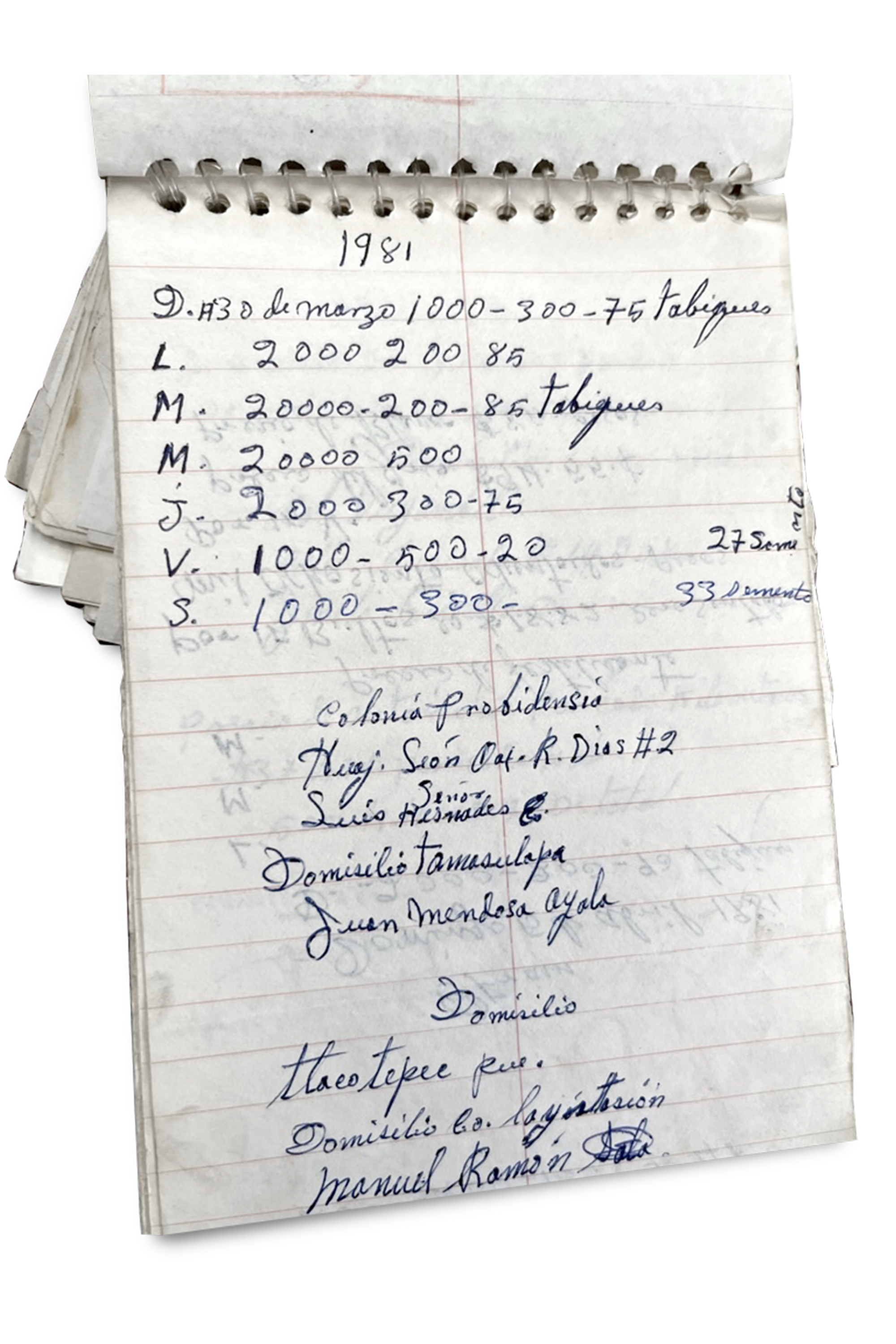
When my father and two of his brothers, Jorge and Saturnino, joined Pedro in Washington in the late 1980s and early 1990s, with remittances paying the coyotes who got them across the border, they shared a room in a house and didn’t get to keep most of the money they earned picking cherries at $4 per seven-gallon crate. They let Pedro allocate part of their paychecks for their living essentials.
The remainder was sent to Huajuapan, where their sisters logged each remittance payment in yet another notebook for Pedro to review each time he returned for visits.
The girls bought new shoes and ate more meat, but along with Pedro’s financial savvy came a stinginess that extended to his family. He refused to pay for any education not provided by the government.
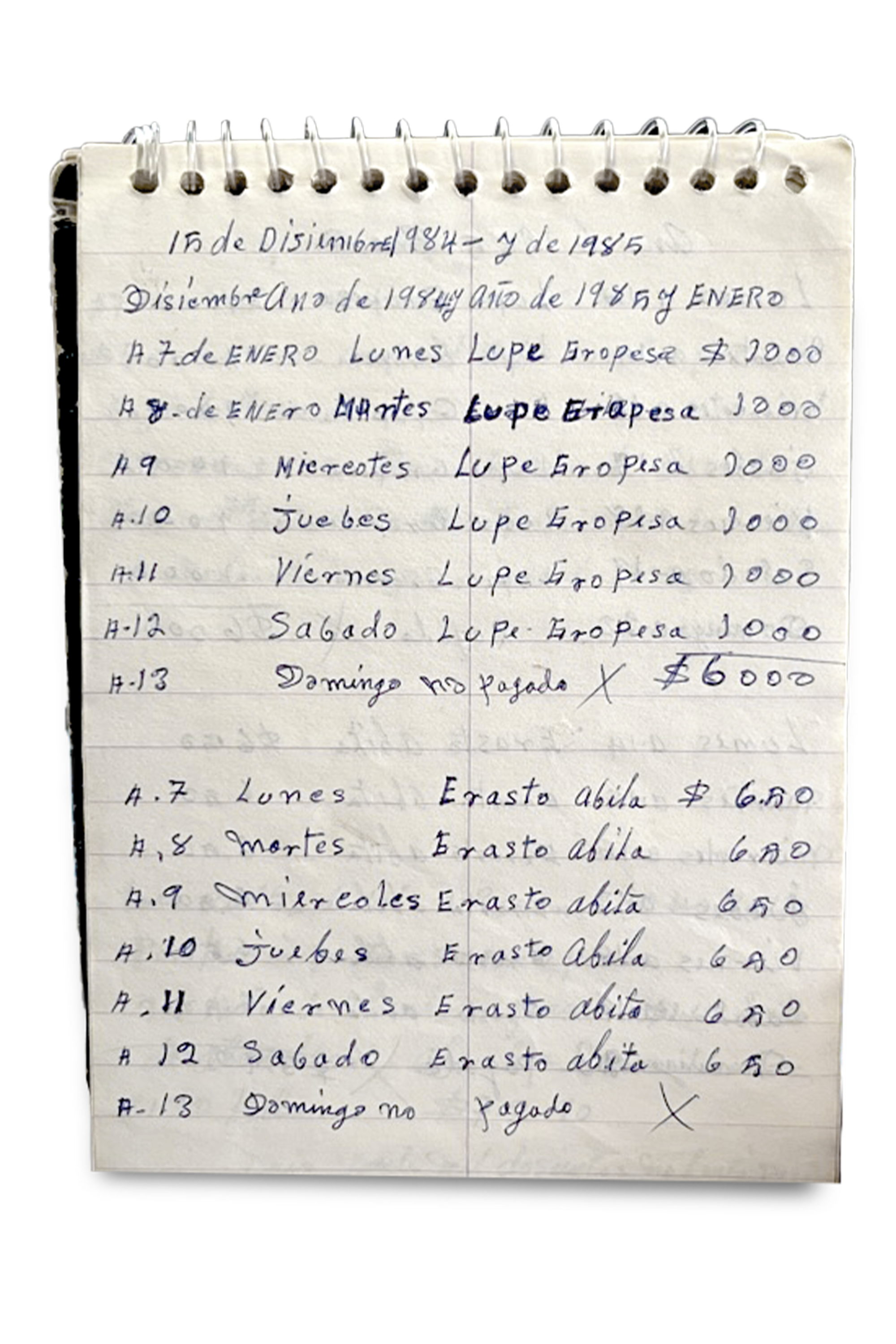
My grandfather never saw the point of using remittances for educational purposes — or for any expense beyond what he deemed immediately essential. This view is common among many Mexican recipients of remittances, either because their finances are so limited that extra money is spent on necessities or because they undervalue education as a key to advancement, according to Tania Castillo Villegas, who studies the effects of remittances at University of the Isthmus in southern Oaxaca.
By the mid-1990s, my father was in his early 20s and starting to become disillusioned with life in the U.S. He had left Huajuapan to avoid becoming a laborer like his father, and yet the only jobs he could find were in Wenatchee’s orchards.
Soon, he stopped taking agricultural jobs, enrolled in English classes at a community college and began to work in restaurants. Using the same method of accounting pioneered by their father in the blue notebooks, he and his brothers directed their remittances to go toward their sisters’ education.
My dad paid for his sister Nubia’s accounting school. Daifa Norma went to a teachers’ college in Mexico City, and Maribel went to Oaxaca City for nursing school.

July 25, 1999. Lupe and Herminia picked 21 boxes of cherries.
Eventually, Pedro, now 80, settled permanently in Huajuapan, his spine bent by years of climbing ladders with 40-pound bags of apples on his back. Macular degeneration slowly took over his vision until he was blind. And in July 2023, after coughing up blood for several days, he stopped eating altogether.
His gallbladder might burst at any time, a doctor warned, and the family had to decide whether Pedro was strong enough for surgery. Although an operation was risky, and the doctor gave a 20% probability of a full recovery, the chances of survival appeared lower without an operation.
The family opted for surgery at a private hospital in Huajuapan rather than at the nearest public hospital in Oaxaca City, which would have required a bumpy three-hour ambulance ride.
Sergio, my father, arrived a day after the surgery, using the frequent flier points he had stockpiled for years to secure a last-minute flight from Seattle to Mexico City. When he arrived in Huajuapan, he was still unsure of his father’s fate. At the hospital, he walked into Pedro’s room and found him awake and responsive. The toxic gallbladder floated in a dark liquid inside a plastic jar on the bedside table.
The decision to take Pedro to a private hospital rather than a subsidized public institution, despite the uncertainty of what the final bill would total, exemplifies the family’s financial stability. The hospital bill exceeded 100,000 pesos (roughly $6,000), an astronomical price for many in the region but a cost that the family could afford with contributions from Pedro’s children.
Remittances did not pay for Pedro’s potentially lifesaving surgery, at least not directly. But they did facilitate the generation of wealth that allowed my father and his siblings to save money for unexpected medical expenses. My aunt Maribel, the family nurse who tended to Pedro’s wounds after his surgery, gained the skills she had from the investment of remittances.
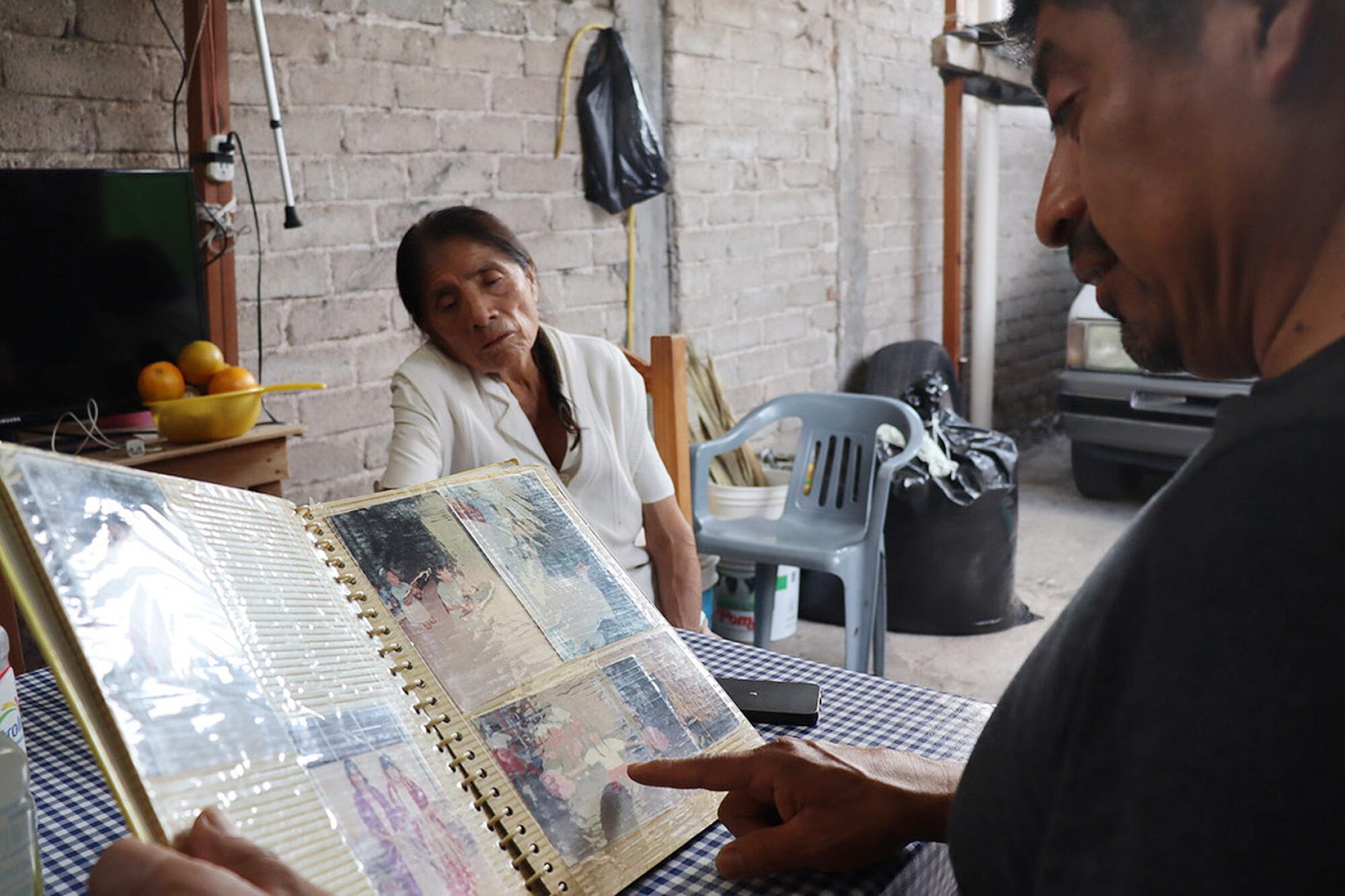
It has been years since the family has been concerned about having enough to eat. Though the family once relied on a field they planted with crops, that field has essentially been allowed to go wild, with corn and cactus growing on their own, along with avocado and mango trees. Herminia and Pedro now harvest whatever the field yields — something to supplement the pounds of meat and masa that are purchased each week to feed the home’s eight permanent residents: an assortment of children and grandchildren, and a handful of regular visitors.
The family has, in a way, grown out of its dependence on remittances.
My father, who got his green card in 2000, no longer pools money or sends set amounts each month. The investments he and his brothers made in education have paid dividends for those still living in Mexico. Norma is a teacher in Mexico City, Maribel a nurse in Huajuapan. The third generation, my cousins, are able to take private English classes and participate in enrichment programs that my father and his siblings could only have dreamed of.
Other Mexican families have not been as fortunate as mine. Sometimes, accidents or injuries prevent migrant workers from making enough to send money that can accumulate as wealth. In some households, remittance money is “spent on something without any benefit for the family,” said Castillo Villegas.

July 23, 1991: Pedro and Herminia picked 28 boxes of cherries. Saturnino and Jorge left for Mexico.
Shortly after my grandfather’s surgery, on a rainy evening in Huajuapan, my cousin Carmen Méndez Martínez sprinted across the concrete driveway to where the family was seated at a table.
“ ¡Me aceptaron en la UNAM !” she said, panting. She had been accepted to attend the National Autonomous University of Mexico, the country’s most prestigious public university.
The adults congratulated her, but their tone was somber. It meant that Carmen would be leaving Huajuapan and, if her aspirations of exploring the world as a doctor were fulfilled, she would not be returning. For Nubia, her mother, it brought to light concerns of the family’s closeness. Would her daughter visit? Would she still feel a duty to help her family?
Carmen is one of 16 grandchildren under the age of 21; the return on my family’s educational investment is just beginning. One cousin wants to be a dentist, another wants to join the U.S. military. Inevitably, they will continue to spread out. And to think those ambitions can be traced back to ledger entries such as “December 5, Friday. Eight hours pruning apples with Eri.”
Three weeks after Carmen was accepted to UNAM, she was on her way to Mexico City. She said her goodbyes to her stoic aunts and siblings, tears in their eyes. When she got to Herminia, her grandmother, Carmen bowed her head for a blessing.
Xavier Martinez is a special correspondent.
More to Read

‘Something more dream-like’: These butterflies tell an unexpected story about migration
April 22, 2024
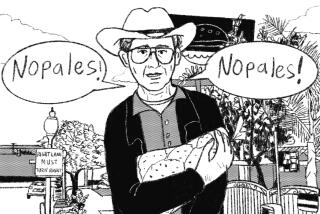
Op Comic: My Mexican grandfather’s infinite garden
March 18, 2024

Opinion: ‘Work longer’ is no solution for people who can’t afford to retire
Feb. 26, 2024
Start your day right
Sign up for Essential California for news, features and recommendations from the L.A. Times and beyond in your inbox six days a week.
You may occasionally receive promotional content from the Los Angeles Times.
More From the Los Angeles Times

World & Nation
After Hamas killed his mother, an Israeli man chooses peace over vengeance
April 24, 2024

Inspired by reality TV, Buddhist monks become matchmakers

Entertainment & Arts
This trans author toured red-state libraries. What she found might surprise you
April 17, 2024

This L.A. director made a film in Russia. The Kremlin wasn’t happy. Then came death threats
April 10, 2024

IMAGES
VIDEO
COMMENTS
Meet Brian and Dixie from the Bureau of Engraving and Printing. Learn how money is made at the Bureau of Engraving and Printing.For more information: https:...
Field Trip to the Money Factory Elementary / Math / Money. USAgov. Oct 11, 2011. 117817 views. Money. Learn how money is made at the Bureau of Engraving and Printing. MORE. BRIEF SUMMARY OF THE VIDEO This video enlightens the public on the intrinsic steps that American currency passes through during production. The designer first develops a ...
Also see how money is printed - September 2011. Meet Brian and Dixie from the Bureau of Engraving and Printing. Also see how money is printed - September 2011 ...
Kids.gov Presents: Field Trip To The Money Factory #LIVE
Below, find five (5) fun, low cost easy to execute field trips that will help any parent or educator teach kids about money. Start teaching kids about money when the are young!!! (1) Field Trip to the Bank. Visit your local bank. It is a fun and free way to help children learn about money and more, like math, business and banking.
Spoke to Jay Stephens of Money Management International and Kenneth Polley of Charles Schwab about the current state of consumer credit, and how people can begin the process of getting out of debt. ... Field Trip to the Money Factory Find out how money is created! Figure it out. Renting vs. Buying a Home Figure the math behind renting versus ...
Episode Resources and Lesson Plans. Graphic Organizer for episode. Parts of a Coin: from the US Mint. Symbols and numbers on the dollar bill: from The Bureau of Engraving and Printing. Field Trip to the Money Factory: See how our bills are made, from usa.gov.. Have a civics question?
Bank Bonanza: Visit a local bank and discover the secrets of money management. Take a tour of the bank and learn about different bank accounts, such as savings and checking accounts. See how money is kept safe in vaults and learn about the importance of saving and budgeting. Thrifty Thrift Shop: Head to a thrift shop and embark on a treasure ...
Field Trip to the Money Factory (video) Watch a video of a trip to the money factory to see and learn how money is made. This slide show explains exactly how the United States government designs and prints money. Money Flash Cards. Practice your knowledge of money values and adding coins and bills with this game. Barter vs. Money (PDF)
Money Field Trip at the Mall. Individual and team Money Missions teach students how to: Develop their own ideas of managing their shopping within a budget. Shop around and ask the right questions to get the best deals. Quickly calculate sale and promotional discounts. Calculate the number of hours they would have to work to pay for certain items.
Field Trip to the Money Factory at Federal Bureau of Engraving and Printing, 9000 Blue Mound Rd, Fort Worth, TX 76131, United States,Fort Worth, Texas, Haslet on Fri Apr 12 2024 at 09:00 am. Field Trip to the Money Factory Fri Apr 12 2024 at 09:00 am UTC-05:00
The United States Mint is located at 151 N. Independence Mall East, Philadelphia, PA 19106 (on 5th Street between Arch Street and Race Street). The United States Mint does not provide parking. From the South: Take I-95 North to Exit 22 for "Central Phila/I-676". Follow signs for Phila/Independence Hall/Callowhill Streets.
Tours and Facilities. More than 1,600 employees work at six United States Mint facilities: Philadelphia, PA - Production Facility. San Francisco, CA - Production Facility. Denver, CO - Production Facility. West Point, NY - Production Facility. Fort Knox, KY - Bullion Depository. Washington, DC - Headquarters.
Segio and Amy did a wonderful job leading my large group of 33 high schoolers through the tour and activities. Michael from Field Trip Factory was also an amazing help in scheduling and figuring out logistics for this trip. Eduardo - Jobs for Progress ComEd Powering Lives Community Center - Chicago, IL. Everything went well from the arrival ...
Field Trip to the Money Factory. Post navigation. Previous Post Previous How Money Is Made - Making of the New 20 Euro. Next Post Next You Make $320,000 A MONTH?!? - Dave Ramsey Show ... E-bike shops will have to float money for state credits for nearly a year 9News.com KUSA. Power of the Purse helps raise money for Beaufort County United ...
Run wild at the Denver Museum of Nature & Science and find everything from dinosaurs to Egyptian mummies, now featuring two new exhibitions: The Art of the Brick, famous artworks made out of LEGO® bricks, and Dogs! A Science Tail, an interactive look into what dogs are thinking; go on a safari at Denver Zoo, featuring the latest exhibition ...
Free community events are another great way to save on homeschool field trips. Often cities or non-profit organizations will sponsor free events. Keep an eye out for these on local news websites and social media. What's available will vary by area, but these can include things like cultural heritage events, musical performances, outdoor ...
The cool est thing about homeschooling is that it provides so many opportunities to structure and learn in locations outside of the home and away from the traditional classroom settings.. While the content and lesson planning is important for the day-to-day of homeschooling, there's some wiggle room in deciding what places to take educational field trips throughout the duration of the year.
Meet Brian and Dixie from the Bureau of Engraving and Printing. Learn how money is made at the Bureau of Engraving and Printing.
For field trips beginning May 1, 2024, the rates are $14 for Greenfield Village, and $12 each for Henry Ford Museum of American Innovation and Ford Rouge Factory Tour. Trips before May 1 are charged at the 2023 rate of $10/student per venue and $8.50/student for Giant Screen Experience. The rate is the same for students and adult chaperones.
Intramuros has always been a classic field trip destination. Up to now, the Walled City does not disappoint. Renovations and improvements are constantly being done to preserve the old-world charm of the site. Also read: DIY Walking Tour in the Walled City of Intramuros: Top 8 Attractions to Visit. 2. Gardenia Factory Image credit: Democraticsystem
Field trips must be scheduled in advance and are typically limited to 30 participants per tour. For more information or to schedule a field trip, call 1.800.987.6409. Field Trip Factory brings lessons on a variety of subjects, such as the arts, nutrition, the environment and animal welfare, to life by providing hands-on activities in real-world ...
On his first trip home, Pedro brought an envelope thick with cash. It was the largest sum of money the family had ever deposited in a bank at one time: $3,600. Pedro Martínez, left, and two other ...